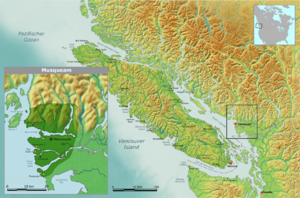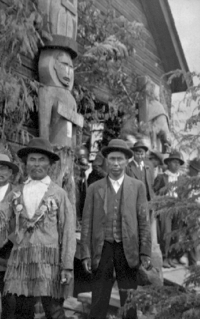Musqueam Indian Band facts for kids
Quick facts for kids
Musqueam
xʷməθkʷəy̓əm
|
|||
|---|---|---|---|
|
First Nations band
|
|||
|
|||

Territory of the Musqueam Indian Band
|
|||
| Country | Canada | ||
| Province | British Columbia | ||
| Government | |||
| • Type | Band council | ||
| Area | |||
| • Total | 1,448.88 km2 (559.42 sq mi) | ||
| Time zone | UTC-8 (PST) | ||
| • Summer (DST) | UTC-7 (PDT) | ||
| Postal code span |
V3H, V3J–N, V3V
V4C, V4K, V4G V5- to V7- |
||
| Area code(s) | 604, 778 | ||
| Ethnic groups | Coast Salish | ||
| Languages | Halkomelem, English | ||
The Musqueam Indian Band (English: ![]() i/ˈmʌskwiəm/ mus-KWEE-əm; Halkomelem: xʷməθkʷəy̓əm IPA: [xʷməθkʷəjˀəm]) is a First Nations band government in the Canadian province of British Columbia. It is the only First Nations band whose reserve community lies within the boundaries of the City of Vancouver.
i/ˈmʌskwiəm/ mus-KWEE-əm; Halkomelem: xʷməθkʷəy̓əm IPA: [xʷməθkʷəjˀəm]) is a First Nations band government in the Canadian province of British Columbia. It is the only First Nations band whose reserve community lies within the boundaries of the City of Vancouver.
Contents
Name
The name Musqueam comes from the flowering plant məθkʷəy̓, which grows in the Fraser River estuary. There is a sχʷəy̓em̓ that has been passed on from generation to generation that explains how they became known as the xʷməθkʷəy̓əm – People of the məθkʷəy̓ plant. Their name is one of the ways that their historical connection to the land is highlighted.
The old people spoke of a small lake called xʷməm̓qʷe:m (Camosun Bog) where the sʔi:ɬqəy̓ (double-headed serpent) originated. They were warned as youth to be cautious and not go near or they would surely die. This sʔi:ɬqəy̓ was so massive that its winding path from the lake to the stal̕əw̓ (river) became the creek flowing through Musqueam to this day. Everything the serpent passed over died and from its droppings bloomed a new plant, the məθkʷəy̓. For this reason, the people of long ago named that place xʷməθkʷəy̓əm (Musqueam – place of the məθkʷəy̓).
History
The Musqueam people are the oldest known residents of Vancouver. The Great Marpole Midden (also known as the Eburne Site, or Great Fraser Midden), is an ancient Musqueam village and burial site located in what has been developed as the Marpole neighbourhood of Vancouver, British Columbia.
This area was also known as the Great Fraser Midden. The midden is a thousands-year old site from which as many as seventy-five human skeletal remains of Musqueam ancestors were excavated. Additionally, Musqueam ancestral belongings (commonly referred to as "artifacts") were also found in the area such as: stone and wooden tools, artwork, and biofacts such as shells and other animal remains. The village was known as c̓əsnaʔəm. Formerly there was a second residential area near the current one, maləy̓, known in English as Mahlie.
The Musqueam's ancestors, the Coast Salish, have lived in the Fraser River estuary for thousands of years. Musqueam describes their traditional territory in their Musqueam Declaration, which was ratified by Musqueam community leaders June 10, 1976.
The Musqueam Declaration describes their traditional territory as follows:
The lands, lakes and streams defined and included by a line commencing at Harvey Creek in Howe Sound and proceeding Eastward to the height of land and continuing on the height of land around the entire watershed draining into English Bay, Burrard Inlet and Indian Arm; South along the height of land between Coquitlam River and Brunette River to the Fraser River, across to the South or left bank of the Fraser River and proceeding downstream taking in the left Bank of the main stream and the South Arm to the sea, including all those intervening lands, islands and waters back along the sea shore to Harvey Creek, AND, the sea, its reefs, flats, tidal lands and islands adjacent to the above described land and out to the centre of Georgia Strait.
—Council & Chief & Musqueam Community, Musqueam Declaration
The area of the Musqueam Reserve is the closest that Hudson's Bay Company explorer Simon Fraser reached to the Strait of Georgia; he was driven back by hostile Musqueam who had had bad experiences with Europeans on ships just prior. Chief Whattlekainum of the Kwantlen warned Fraser of an impending attack, thereby saving his life.
Language
Their traditional language is hən̓q̓əmin̓əm̓, the Downriver Dialect of the Salishan language Halkomelem; they are closely related to neighbouring peoples of the lower Fraser River. The nearby Kwantlen and Katzie peoples just upriver share the same hən̓q̓əmin̓əm̓ dialect, while the upriver Sto:lo people speak another dialect, Halq’əméyləm (known as the Upriver Dialect). The Cowichan, Chemainus, Snuneymuxw and neighbouring Coast Salish peoples of Vancouver Island and the parts of the Gulf Islands of the southern Gulf of Georgia speak another dialect, Hul'qumi'num' (usually spelled Hulquminum), often called the Straits dialect, or Island Halkomelem. It is not to be confused with North Straits Salish, which is a group of related dialects to the south.
In early 2018 the University of British Columbia installed at its main Vancouver campus 54 street signs in the Musqueam language, written in Americanist phonetic notation. (In 2010, UBC’s Okanagan satellite campus had put up signs in Nsyilxcen, the language of the Okanagan Nation. Before the 2010 Olympic Games, the British Columbia government installed road signs in Squamish, Lil’wat and English on the Sea-to-Sky Highway between Whistler and Vancouver, BC.)
The xʷməθkʷəy̓əm Musqueam dialect, hən̓q̓əmin̓əm is from the Hul’q’umi’num’/Halq'eméyle/hən̓q̓əmin̓əm language family.
Indian Reserves
Indian Reserves under the administration of the band are:
- Musqueam Indian Reserve No. 2, at the mouth of the Fraser River to the north of Sea Island, 190.40 ha. 49°14′00″N 123°13′00″W / 49.23333°N 123.21667°W
- Musqueam Indian Reserve No. 4, to the east of Canoe Passage near Westham Island, 57.30 ha. 49°04′00″N 123°07′30″W / 49.06667°N 123.12500°W
- Sea Island Indian Reserve 3 (Halkomelem: sqʷsaθən), on the northwest corner of Sea Island, 6.50 ha. 49°12′35″N 123°12′00″W / 49.20972°N 123.20000°W




